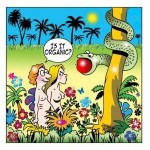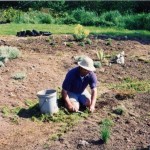I think of it as alive and beneficial. Have you had problems with such?
Absolutely. When people dump their virused peony, iris, dead maple prunings with verticillium wilt or anthrocnose fungi it stays in the soil and even with bleaching you cannot kill it off.
A lot of people even throw in their cat and dog poop litter in that truck load. One local nursery locally was closed down FOREVER for soil born contamination of something.

Monrovia Nursery accidentally contaminated the whole country with an oak tree killing fungus that found foothold in its CA production facility. It was not caught as that near desert area is not prone to such a problem. However with recycled water and daily irrigation it thrived. Other nurseries have exported other blights in their soil mixes.
Throw in accidental infections and one can catch Sporotrichoses.
This skin disease, usually is associated with roses, but lives in all sorts of natural mediums one should always be concerned about “composts” sphagnum moss or soil mixes. This is a very common skin affliction caught by workers in tree nurseries, garden centers and or even people handling hay bales. Wear gloves, especially if you have any open cuts or wounds on your hands or arms.
Many decades ago a major bagged soil company which shall go nameless produced a great product, but some of the ingredients were later to be found to be harmful. Not only the vermiculite/perlite, but it also included bat guano. This was later taken out and many safety precautions were issued like wear masks and gloves when handling.
I wonder today how many customers developed issues from that bat guano.
The common aspergillus fungi, (a common mold) loves decaying matter and other environments as well. Be it backyard composting or buying it in from others, controlling fungi is a difficult process. Buying from soil yards that accept and process diseased yard waste is asking for trouble because they rarely have the tools to adequately measure the temperature and using a back hoe to mix the material is not sufficient.
Our local Pt. Townsend waste treatment center does use the proper thermometers and mixes the stuff efficiently. But unless the ENTIRE mix has come to 130 to 140 you are asking for trouble. 

Best of all, this heating needs to be done in two FIVE day heating cycles …. and after that you CURE your compost for months before selling it or applying it to your soil. The profit issue makes that a joke. Heat it up, turn it over a couple of times and your done.
BTW – that does not even get into the other materials that is thrown in. Nails from partially decomposed pallets, roof shingle debris etc. I found all these in a mix I mistakenly received. The other yard was closed, and his topsoil mix had none of this … so the person hired to deliver went to the other place. My mistake!!!
Nor is one protected from chemicals also added inadvertently or by oversight. Casaron from mulched beds, copper or zinc from roof treatments that fall to the ground or raked up leaves. Such chemicals are not that affected by composting.
Sadly, much that is sold as safe and organic often is not. Back in the 80’s the Eco-friendly ‘organic’ and wonderful fertilizer Milorganite (Milwaukee processed sludge) was found to have high levels of many metals such as nickle, arsenic, zinc and cadmium.
Today, it has been reformulated and is made and monitored better than it was back then. That said, with the EPA being castrated now, one needs to rely upon the manufacturer to remain complaint with old laws. Will it be enough? Sludge use as with yard waste should always be carefully examined. Waste water, heck even drinking water in America sometimes is not safe. Pharmaceuticals, pathogens, flame retardants, heavy metals all may be in that sludge.

Applying such to a golf course lawn, tree farm may be great but I would caution about putting it into your organic garden plot. Common sense would look at the cautionary (applies equally to most fertilizers a well) “WARNING this product contains detectable quantities of chemicals known to cause cancer, birth defects, or other reproductive harm. This notice in no way implies that we have any evidence or experience to indicate that any genuine hazard of cancer, birth defects, or reproductive harm results from the normal, proper handling described on our label and related literature.”
I have digressed as I often do, but I return to my beginning caution. Buying yard waste compost is a gamblers game.
On a personal note. I am now closing in on 70 and after near fifty years in the Nursery/Garden Center business I am now more than certain that some of my latter health issues are related to the chemicals I was exposed to. Be it the gardens I applied fertilizer to, the Copper spraying of orchards, applying zinc powders to roofs and of course the application of round-up or 2-4-D weed killers to landscape maintenance.
It all adds up. Today I have Neuropathy and liver disease and must deal with those late life limitations.
I appreciate all those warning labels that the companies apply to their products, but when it comes to merchandising they advertise them as being benevolent. I cannot begin to tell you how many times I have observed people spraying weed killer on their lawns in shorts and tennis shoes. No gloves, no mask. I guarantee, it will catch up to you sooner or later.
(Visited 115 times, 1 visits today)

Wow this is really good. A little out of my ball park, but really a good read.
I would only add that if you happen to feel you do need to use a pesticide, herbicide, or a fertilizer, please understand and follow the label precisely. Many times it’s tempting for homeowners to think “if a little might work, more will be better”. No! Follow the label. It’s the LAW.
Please consider the pollinators and by all means, LET THAT CLOVER and THOSE DANDELIONS GROW !!! They are far more beautiful than a sterile green desert of lawn grass.
Follow the label. It’s the LAW.
Yes – great point, but also use common sense. Do not spray when your drift will impact the neighbor. I lost a beehive and had to burn the foundation and honey for one such incident. My hedge of Filberts also defoliated. In CA. we had laws that covered such damage. Here I would need to go to small claims court.
“respect the earth and respect your neighbor” might be another good law to follow.
The GOLDEN RULE of Christianity is mirrored by others as well:
• Confucianism: “Do not do to others what you do not want them to do to you” (Analects 15:23)
• Hinduism: “This is the sum of duty: do not do to others what would cause pain if done to you” (Mahabharata 5:1517)
• Buddhism: “Hurt not others in ways that you yourself would find hurtful” (Udanavarga 5:18)
Insects and other creatures also would appreciate the use of less chemicals and hopefully with this Covid virus, the damn lawn might finally die.
Plant vegetables, flowers … whatnot. Anything but that sterile green desert.
“Do unto those downstream as you would have those upstream do unto you.” -Wendell Berry
One common test you can make on your OWN triple decked compost pile is to insert a lot of tomatoes in it. If they survive to come to seed, you know you have not hit 135.F. A good deep thermometer will assist in determining this. Sticking your hand in may be a good indicator but not for the corners or the bottom of the pile.
“After a week at 130 ° F (55 ° C)*, most weed seeds will be dead, but it takes a month at 145° F (63 ° C) or more to kill the most resistant ones.”
https://laidbackgardener.blog/2018/08/26/how-to-kill-weed-seeds-in-compost/
Turning it religiously does a couple of things, by aerating it you oxygenate the pile allowing helpful microbriota that make it all happen. You also move the colder sections of the pile into the center so all the pile gets heated eventually.
Just remember it takes a month of a hot pile to really digest and compost material properly.
Do NOT put diseased things in. Burn them!!!
Between now and fall gardeners will have tons of opportunities to find composts, soils, bagged leaves etc.
One thing to watch out for might be FREE lawn clippings as they may be full of herbicides. Seeing what some of my neighbor’s apply just freaks me out.
Local utility companies trim trees and their tree chips would be a great thing to be put on a waiting list for. That stuff heats up fast and usually is pretty good. Only downside being that you might get some fungi that appear, but they usually would not be a problem to you, the kids or your plants. Their feast is on the wood cellulose.
SOME might be a problem, but it is negligible. (fairy rings) Check out the following link.
https://ag.umass.edu/landscape/fact-sheets
https://ag.umass.edu/landscape/fact-sheets/fungi-in-mulches-composts